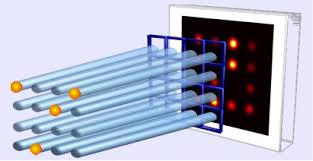Astrophotonics
Optical astronomical interferometry is currently delivering extremely high resolution images of proto-planetary disks and star photospheres. The technique relies on the interferometric combination of the light collected by an array of several distant telescopes. The achieved resolution is comparable to that of a monolithic instrument with a diameter equal to the largest separation between two telescopes in the array (currently, a few 100 meters). Photonics can greatly improve the performance of astronomical instruments and possibly enabling arrays extending over more than 1 Km in the near future.
Focus of my recent research in the field of Astrophotonics (= photonics applied to astronomy) has been the development of an advanced metrology system for VLTI and a new concept for photonic beam combination for an arbitrary large array of telescopes.
MAMMUT, a metrology system for VLTI
The Mirror vibrAtion Metrology systeM for the Unit Telescope (MAMMUT) is a cooperative project with the European Southern Observatory (ESO) aimed at implementing a laser metrology system to monitor the vibrations of the mirrors of the 8 m telescopes (Unit Telescopes – UTs) at the Very Large Telescope Interferometer in Chile. High frequency mechanical vibrations in the optical train of the UTs are currently limiting the performance of the VLTI to bright targets. MAMMUT uses a stabilized fiber interferometer to deliver a metrology beam directly in the telescope. The optical path difference between the two tips of the 250-m-long fiber interferometer is better than 20 nm. Work is in progress to implement an active control of differential chromatic dispersion to enable fiber interferometers like MAMMUT for fiber links in interferometric arrays.
References:
S. Minardi et al. Astron. Nachr. 330, 518 (2009). – arxiv.
I. Spaleniak et al. SPIE 7734-145 (2010). – preprint
The Discrete Beam Combiner
 Fast astronomical events such as planet transits or supernovae explosions would require the simultaneous combination of many telescopes (beams). A promising approach is to use integrated photonic circuits to perform the combination of the beams. In my work I have investigated the possibility to use 3D photonic elements to achieve this task and overcome the limitations of existing planar photonic circuits. As a result, I have found that 2D arrays of coupled waveguides could be used to retrieve the complete interferometric information from 3 or 4 telescopes. Work is in progress to demonstrate experimentally the concept and to scale the result to an arbitrary array of telescopes.
Fast astronomical events such as planet transits or supernovae explosions would require the simultaneous combination of many telescopes (beams). A promising approach is to use integrated photonic circuits to perform the combination of the beams. In my work I have investigated the possibility to use 3D photonic elements to achieve this task and overcome the limitations of existing planar photonic circuits. As a result, I have found that 2D arrays of coupled waveguides could be used to retrieve the complete interferometric information from 3 or 4 telescopes. Work is in progress to demonstrate experimentally the concept and to scale the result to an arbitrary array of telescopes.
References:
S. Minardi, T. Pertsch, R. Neuhauser SPIE 7734-136 (2010) – preprint
S. Minardi, T. Pertsch Opt. Lett. 35, 3009 (2010) – arxiv
S. Minardi, Month. Not. R. Astron. Soc. 422, 2656 (2012) –
S. Minardi, et al. Opt. Lett. 37, 3030 (2012) –
A. Saviauk, S. Minardi et al. Appl. Opt. 52, 4556 (2013) –
